Peek into the Bible's ancient texts to discover startling parallels with modern nuclear warfare, and uncover prophecies that may hint at our future.
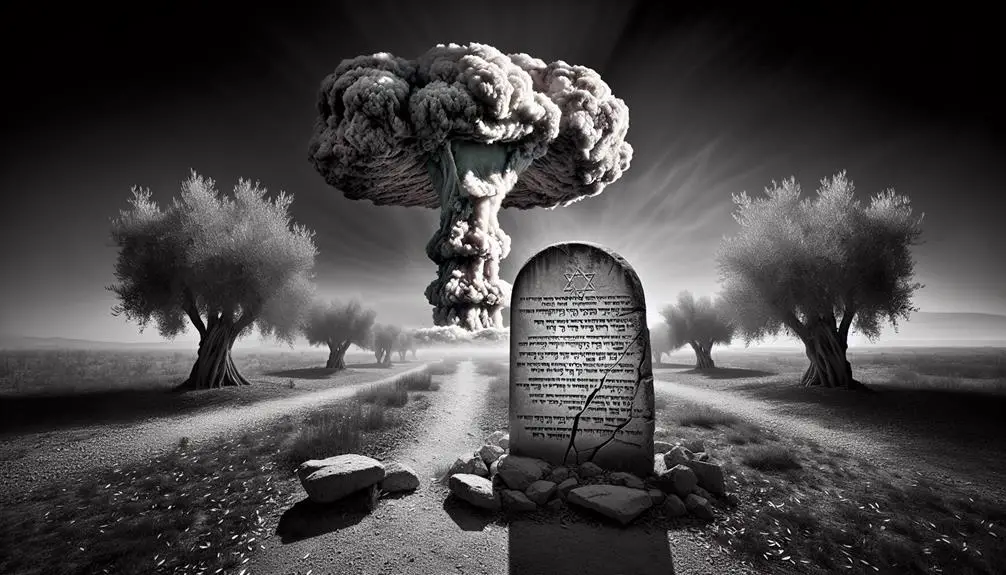
Nuclear Weapons in the Bible
As you peel back the layers of ancient scripture, it's like uncovering a hidden arsenal, suggesting that the Bible may have foretold the advent of nuclear weapons centuries before their creation.
From the fiery destruction of Sodom and Gomorrah to the apocalyptic visions in Revelations, you'll find threads that some argue weave a narrative eerily reminiscent of modern nuclear warfare.
This exploration isn't just about connecting historical dots; it's about understanding how ancient prophecies might be interpreted in the light of today's global threats.
Let's embark on this journey together, and you might find the past has much to say about our future.
Key Takeaways
- Biblical prophecies use apocalyptic symbols that can be interpreted as allusions to modern nuclear devastation.
- Prophetic visions emphasize divine judgment and redemption, echoing concerns over the ethical use of nuclear power.
- The fall of Babylon is seen as a metaphor for the potential self-destruction of empires through unchecked technological growth.
- Ancient texts provide a unique lens to view contemporary ethical dilemmas regarding mankind's stewardship over nuclear weapons.
The Prophetic Landscape
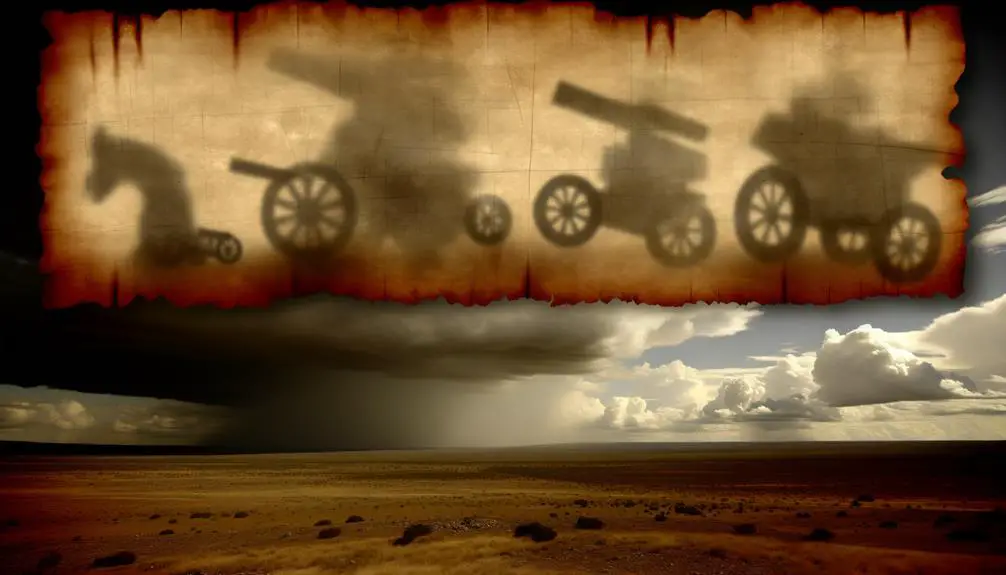
Throughout history, many have interpreted biblical prophecies as foretelling modern events, including the advent and use of nuclear weapons. This interpretation hinges on the depiction of apocalyptic symbols and narratives that, to some, resonate with the catastrophic potential of nuclear warfare. These symbols, often steeped in metaphor and allegory, serve as a canvas for depicting divine interventions in human affairs, particularly at times perceived as the end of days.
In the prophetic landscape of the Bible, imagery such as fire raining from the sky, the obliteration of cities, and the suffering of nations are interpreted by some as allusions to nuclear devastation. Scholars and theologians argue that these apocalyptic symbols aren't literal forecasts of specific events but rather represent the overarching theme of divine judgment and redemption. The concept of divine interventions as a response to human iniquity, therefore, becomes a focal point in understanding the biblical narrative in the context of modern existential threats.
Moreover, the analytical examination of these prophecies reveals a complex interplay between divine will and human agency. The imagery of destruction and renewal serves as a reminder of the potential consequences of humanity's actions, viewed through the lens of divine providence. In this sense, the prophetic texts offer a reflective mirror on the moral and ethical considerations surrounding the development and deployment of nuclear weapons, inviting a deeper contemplation on the role of divine guidance in navigating the perils of human innovation.
This scholarly approach emphasizes the need to discern the symbolic from the literal, urging a nuanced interpretation of biblical prophecy in the context of contemporary global challenges.
Sodom and Gomorrah Revisited
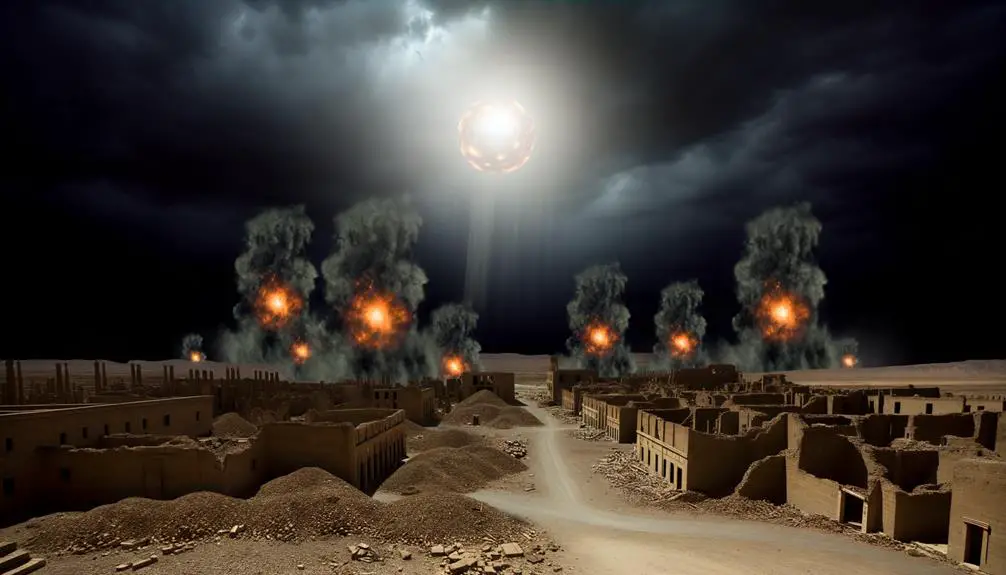
Building on the examination of apocalyptic symbols, let's revisit the biblical narrative of Sodom and Gomorrah as a lens through which to view the potential for nuclear allegory. The destruction of these cities, as described in Genesis, bears striking resemblances to modern understandings of nuclear fallout, prompting scholars to delve deeper into the historical and geographical context to uncover potential parallels.
Archaeological findings have played a crucial role in this analysis, offering tangible evidence that supports the geographical accuracy of the biblical account. Excavations in the region purported to be Sodom and Gomorrah have revealed layers of ash and destruction that align with the timeline of the biblical narrative. This evidence suggests a catastrophic event occurred, lending credibility to the theory that the story might symbolize early human encounters with devastating natural phenomena, possibly perceived as divine retribution.
To engage you in this exploration, consider the following aspects:
- Archaeological Evidence: Discoveries of ash layers that coincide with the biblical timeline of Sodom and Gomorrah's destruction.
- Geographical Accuracy: The locations identified as Sodom and Gomorrah align with descriptions in the biblical account, supporting its historical credibility.
- Symbolic Interpretation: The narrative's potential as an allegory for nuclear devastation, viewed through the lens of modern scientific understanding.
- Cultural Impact: The story's influence on contemporary discussions about morality, divine judgment, and the human capacity for destruction.
As we delve into the historical and symbolic layers of Sodom and Gomorrah, it's crucial to approach the text with both reverence for its religious significance and a critical eye for its implications in today's nuclear age.
The Vision of Zechariah

You must now turn your attention to the Vision of Zechariah, a segment rich with prophetic imagery that warrants a contemporary lens for interpretation.
This analysis will explore how modern interpretations align or diverge from the historical context in which Zechariah's visions were recorded.
Zechariah's Prophetic Imagery
In exploring Zechariah's prophetic imagery, it's essential to recognize the symbolic depth and historical context of his visions. His narratives are rich with angelic messages and instances of divine intervention, illustrating a complex interplay between the spiritual and the earthly realms. Zechariah's visions serve not only as warnings but also as promises of restoration and hope for the future.
- Angelic Messages: Intermediaries between the divine and humanity, providing guidance and revelations.
- Divine Intervention: Direct actions from a higher power influencing events on earth.
- Symbolic Depth: Each element within the visions carries multiple layers of meaning, often relating to spiritual truths and future events.
- Historical Context: Understanding the time and circumstances in which Zechariah lived is crucial for interpreting his imagery accurately.
Modern Interpretations
Having explored Zechariah's prophetic imagery, let's now examine how modern interpretations of these visions continue to shape our understanding of biblical prophecy and its implications for contemporary spiritual discourse.
In the realm of nuclear ethics, scholars draw biblical parallels to express concerns over humanity's capacity for self-destruction. Zechariah's visions, once perceived as mystical and far-removed, now resonate with alarming clarity in an age where nuclear capabilities mirror the catastrophic potential described in ancient texts.
This intersection of theology and modern warfare challenges believers and ethicists alike to reconsider the moral dimensions of power and technology. As you delve deeper, it becomes evident that these scriptural interpretations offer a unique lens through which to view the ethical quandaries posed by nuclear armament, urging a reevaluation of mankind's stewardship over Earth's most devastating forces.
Historical Context Analysis
To fully grasp the implications of Zechariah's vision, it's essential to contextualize these prophecies within their historical period, marked by tumultuous political and social upheaval.
Archaeological evidence offers insights into the material culture of Zechariah's time, shedding light on daily life and religious practices.
Textual discrepancies within the biblical narrative hint at the complex process of its compilation and transmission, influencing interpretations.
The geopolitical landscape of the Near East, characterized by the rise and fall of empires, provides a backdrop to Zechariah's prophecies.
Socioeconomic factors, including trade, warfare, and migration, played significant roles in shaping the community's outlook and expectations.
Understanding these elements is crucial to analyzing Zechariah's vision in its historical context, avoiding anachronistic interpretations and appreciating its original significance.
Fire From the Sky
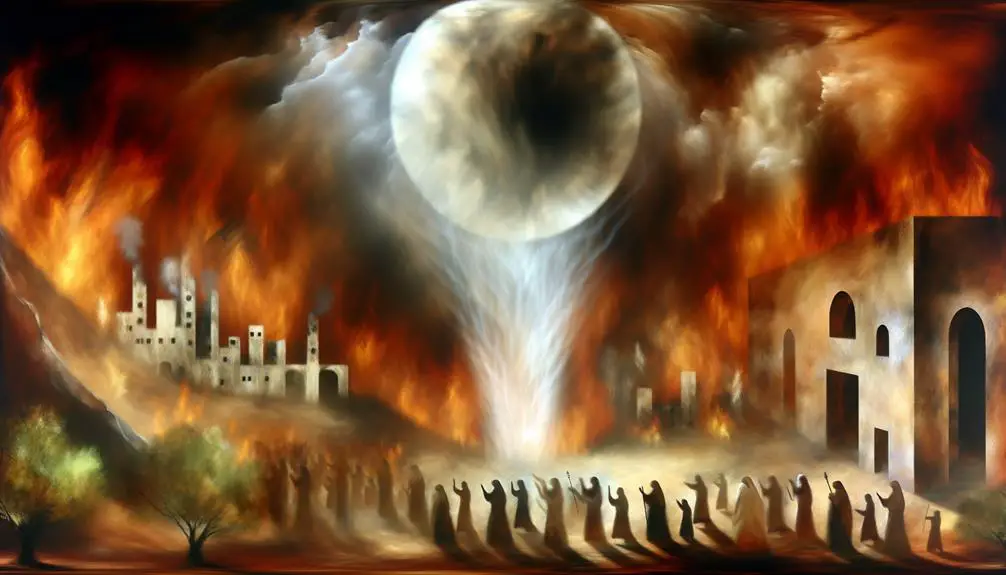
Throughout history, interpretations of biblical prophecies have often pointed to the notion of divine retribution manifesting as fire raining down from the sky. Scholars and theologians have long debated these texts, wondering if they could be metaphorical descriptions of natural phenomena or literal predictions of celestial events. Among the most discussed are meteor showers and solar flares, both of which have the potential to cause significant impact on Earth.
Meteor showers, for instance, are celestial events where numerous meteors are observed to radiate from one point in the night sky. These natural phenomena have been recorded throughout history and often interpreted as signs of divine displeasure or warning. The vivid imagery of stars falling as fire from the heavens could easily be likened to the intense display of a meteor shower, leading some to speculate that ancient texts might've been describing such events.
Solar flares, on the other hand, are sudden eruptions of energy on the sun's surface that can emit vast amounts of radiation into space. When directed towards Earth, these flares can disrupt communications and power grids, but their visual manifestation can also include brilliant auroras. The biblical depiction of the sky ablaze could be an ancient interpretation of these awe-inspiring solar events, perceived as divine communication.
In analyzing these possibilities, it's crucial to approach the texts with a balanced view, recognizing the blend of metaphorical language and historical context. While the idea of celestial phenomena as explanations for 'fire from the sky' adds a fascinating layer to biblical interpretation, it also underscores the complexity of deciphering ancient texts in the light of modern scientific understanding.
The Fall of Babylon
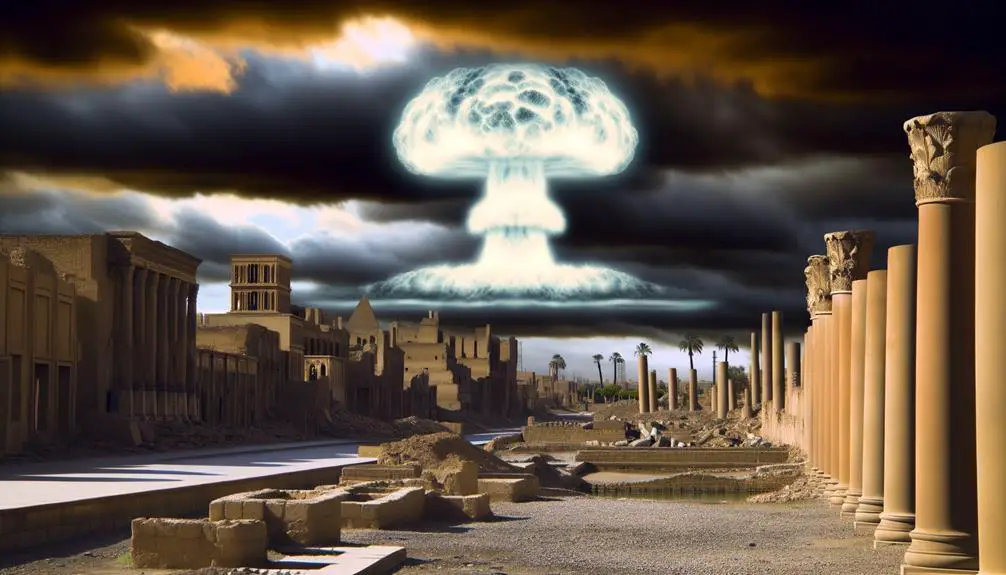
You must now consider the fall of Babylon, a pivotal event that has stirred both historical and theological debate.
The narrative's symbolic destruction and its prophetic interpretations offer a rich field for analysis, particularly when juxtaposed with modern views on apocalyptic events.
This discussion aims to unravel the complexities surrounding Babylon's demise and how it might align with contemporary understandings of nuclear weaponry in scriptural prophecy.
Babylon's Symbolic Destruction
The symbolic destruction of Babylon in biblical texts, often depicted as God's judgment, serves as a profound illustration of divine retribution and the inevitable downfall of corrupt empires. This narrative hasn't only been supported by archaeological evidence but also holds significant cultural impact, reflecting on how societies view the consequences of moral decay and the hubris of power.
- Archaeological Evidence: Finds that corroborate historical accounts of Babylon's fall, lending credence to the biblical narrative.
- Cultural Impact: How the story influences contemporary views on justice and the cyclical nature of empires.
- Divine Retribution: The motif of a higher power punishing arrogance and wickedness.
- Inevitable Downfall: The theme that no empire, regardless of its might, is immune to collapse.
Analyzing Babylon's symbolic destruction offers insights into the interplay between divine justice, cultural perceptions, and historical realities.
Prophecy's Modern Interpretations
Modern interpretations of Babylon's prophesied fall delve into the nuanced realm of symbolic representation, reshaping our understanding of ancient prophecies within contemporary contexts.
You'll find that scholars analyze these prophecies through the lens of current technological advancements and cultural impacts.
This approach highlights the dynamic relationship between ancient texts and modern realities, suggesting that the imagery of Babylon's downfall could metaphorically allude to the consequences of unchecked technological growth and cultural hegemony.
By examining these prophecies, you're encouraged to consider how the themes of power, morality, and destruction intersect with today's global challenges.
This scholarly exploration underscores the timeless nature of prophetic texts, proposing that they offer critical insights into contemporary societal and ethical dilemmas, mediated by technological and cultural evolution.
The Battle of Armageddon
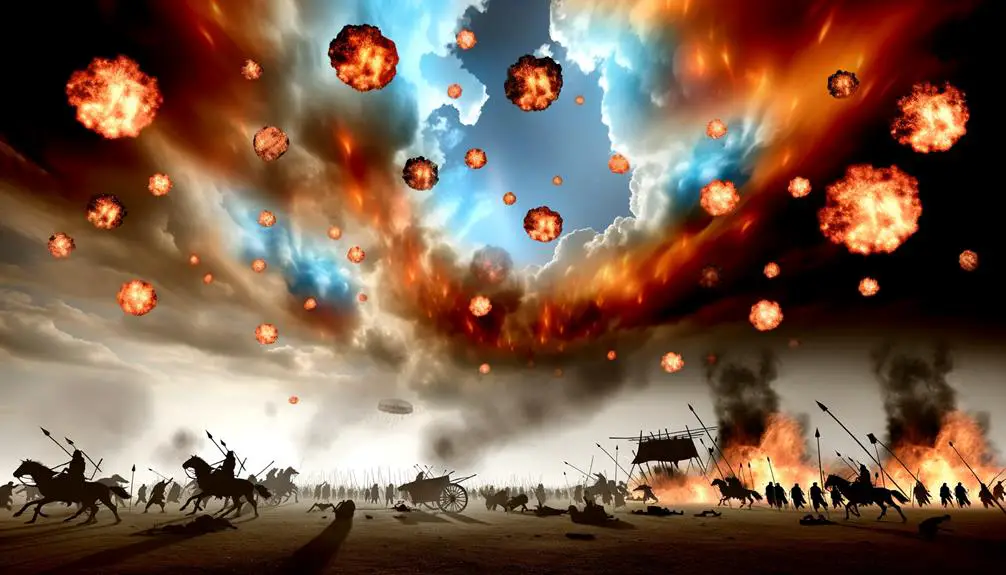
In biblical prophecy, Armageddon represents the ultimate battleground where forces of good and evil will clash in a decisive confrontation. The term itself is deeply rooted in apocalyptic symbolism, often linked to the Megiddo excavation, an archaeological site that has unearthed layers of history believed by some to be the prophesied location. This setting, both real and symbolic, serves as a vivid backdrop to envision the end-of-days scenario depicted in various scriptures.
Analyzing Armageddon requires understanding its multifaceted dimensions:
- Historical Context: The Megiddo site has been a strategic military location for centuries, suggesting that its selection in prophecy might symbolize the culmination of human conflict.
- Symbolic Meaning: Armageddon transcends its literal geographical reference, embodying the ultimate battle between divine and malevolent forces. It's a metaphor for final judgment and the triumph of good over evil.
- Apocalyptic Imagery: The vivid descriptions associated with Armageddon serve to evoke a sense of urgency and the need for moral readiness.
- Prophetic Interpretations: Throughout history, interpretations of Armageddon have varied, reflecting the contemporary anxieties and hopes of different eras.
While the notion of nuclear weapons is modern, the thematic elements surrounding Armageddon—destruction, renewal, and the pivotal role of human morality—remain relevant. Scholars and theologians often debate the literal versus metaphorical interpretations of these prophecies, yet the underlying message of a final reckoning serves as a powerful reminder of the consequences of human actions and the hope for redemption.
Interpreting Ancient Omens
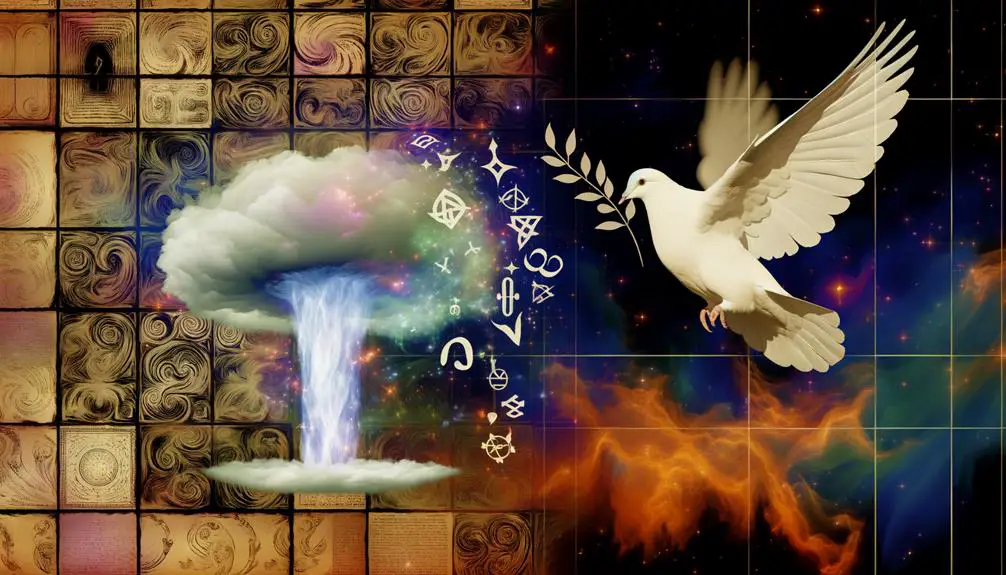
Throughout history, societies have sought to understand their fate and fortune by interpreting ancient omens, a practice that reveals much about human nature's quest for meaning amidst the unknown. These omens, ranging from celestial predictions to mythological interpretations, have played a pivotal role in shaping the worldview and decisions of civilizations.
Omen Type |
Interpretation |
Impact on Society |
|---|---|---|
Celestial Events |
Eclipses and comets were often seen as dire warnings or divine messages. |
Led to significant cultural and political decisions based on fear or awe. |
Natural Disasters |
Earthquakes, floods, and volcanic eruptions were interpreted as divine displeasure or punishment. |
Prompted societal changes, sometimes leading to shifts in leadership or policy reforms. |
Animal Behavior |
The unusual behavior of animals was thought to be a precursor to significant events. |
Influenced agricultural and migration decisions, often leading to the development of folklore. |
Dreams and Visions |
Seen as messages from the divine, guiding or warning leaders and common folk alike. |
Shaped the course of history through decisions made by those who had or interpreted these experiences. |
In dissecting these interpretations, you'll find that ancient societies relied heavily on mythological frameworks to make sense of natural phenomena that were beyond their scientific understanding at the time. This reliance on celestial predictions and mythological interpretations not only highlights the human need for control and comprehension in a chaotic world but also underlines the profound impact such beliefs have had on the course of human history. As you delve deeper into ancient omens, you uncover a rich tapestry of beliefs that have, in various ways, guided civilizations through the ages.
Frequently Asked Questions
How Have Modern Theologians Reconciled the Existence of Nuclear Weapons With Traditional Interpretations of Biblical Prophecy?
You're diving into how modern theologians navigate the ethical paradoxes and technological prophecies presented by nuclear weapons within biblical interpretations.
They meticulously analyze scriptures, seeking connections or contradictions with contemporary technological advancements. Their approach blends analytical rigor with spiritual insight, attempting to reconcile these modern dilemmas with ancient texts.
This scholarly endeavor involves re-examining prophecies and ethical teachings, ensuring they remain relevant and meaningful in today's nuclear age.
Are There Any Biblical Passages That Scholars Believe May Have Inadvertently Predicted the Development of Nuclear Technology?
You're venturing into a realm where ancient texts meet modern marvels. Scholars pore over historical contexts and symbolic interpretations, seeking hints of nuclear technology in biblical passages.
They analyze scriptures with a lens that blends reverence with inquiry, dissecting words for potential foresight into humanity's potent capabilities. While explicit mentions are absent, the analytical, scholarly dive into these texts uncovers layers of meaning that could, perhaps, point to such advancements.
How Do Different Religious Denominations View the Morality of Nuclear Weapons in the Context of Biblical Teachings on War and Peace?
You'll find that different religious denominations face ethical dilemmas when considering the morality of nuclear weapons.
Through the lens of biblical teachings on war and peace, some groups vehemently oppose their use, arguing it contradicts the call for peace and love amongst humanity.
Others, however, may see a strategic or defensive role for them in peace negotiations, believing in a nuanced approach to maintaining global harmony while navigating the complex modern geopolitical landscape.
Has the Discovery and Use of Nuclear Weapons Influenced New Interpretations of Biblical Apocalyptic Literature?
Certainly, the advent and utilization of nuclear weapons have spurred fresh analyses of biblical apocalyptic texts.
You're now seeing scholars delve deeper, balancing historical accuracy with literary symbolism.
They're not just looking at these scriptures as ancient texts but are interpreting them through a modern lens, pondering how these powerful weapons influence understandings of end-times narratives.
This shift in perspective underscores a broader, more nuanced approach to biblical prophecy in today's world.
What Role Do Nuclear Weapons Play in Contemporary Religious Debates About the End Times and the Concept of a "New Heaven and New Earth"?
In contemporary religious debates, nuclear weapons have ignited a firestorm of concern over their role in the end times and the creation of a 'new heaven and new earth.' These discussions often pivot around ethical dilemmas and the call for environmental stewardship.
You're witnessing a complex interplay where beliefs about ultimate destruction intertwine with hopes for renewal, challenging communities to reflect deeply on moral responsibilities in the face of potentially apocalyptic technologies.
Conclusion
In conclusion, while the Bible doesn't explicitly mention nuclear weapons, its vivid depictions of apocalyptic destruction resonate eerily with modern capabilities. From Sodom's fiery demise to Armageddon's ultimate battle, these narratives offer a prophetic lens through which to view contemporary fears.
Isn't it striking how ancient texts echo today's existential threats? This scholarly analysis underscores the timeless nature of human concern with annihilation, inviting reflection on how we interpret and respond to the concept of ultimate destruction.



Sign up